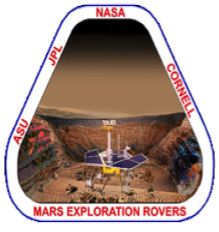
DERIVED DATA SET UNDER CONSTRUCTION
The Mini-TES is a Fourier Transform Spectrometer covering the spectral range 5-29μm (339.50 to 1997.06 cm-1) with a spectral sample interval of 9.99 cm-1. The instrument is located at the bottom of the rover's mast, and scanning mirrors reflect light down to it: thus, it sees the terrain or sky from the same vantage point as PanCam.
Atmospheric Observations
Temperature Profiles - Mini-TES has been pointed upward to 30 deg. above the horizon. Using temperatures retrieved from the wings of the 15-μm CO2 band, this upward-viewing mode yields high-resolution temperature profiles through the bottom few km of the atmosphere. This lowest region of the atmosphere has been difficult to measure on Mars because of the nature of the weighting functions as seen from orbit, and because of the difficulty of determining surface contributions to radiance.
Water abundance - Water vapor abundance was obtained from rotational H2O lines. Separate measurements of water near the ground were obtained by viewing distant surface obstacles. The broad water-ice feature centered near 800 cm^-1 allowed monitoring of ground ice hazes. Together, these measurements will illuminate the behavior of water in lower atmosphere and of water transport between the atmosphere and surface.
Atmospheric dust abundance was obtained using the redundant temperature information in both sides of the 15 mm CO2 band, together with differential absorption across the dust band in that region.
Useful Mission Documents
Derived Data Description
Spectra taken by the Miniature Thermal Emission Spectrometer (Mini-TES) instrument on board Spirit and Opportunity, collected in both the upward-looking and downward-looking geometries, were used to retrieve atmospheric temperatures between 1 and 2000 m above the surface as well as the column optical depth of dust, and the column abundance of water vapor. During this period, which spanned more than a Martian year, Mini-TES observed the annual cycle of temperature variations and the diurnal growth and decay of a near-surface highly superadiabatic layer.
It should be noted that these data were derived from averaged spectra. The original raw and calibrated data reveal random temperature fluctuations on a timescale of less than a minute which could be used to characterize surface turbulence.
Retrieving the Derived Data Volume Derived Data - TBD
Derived Data CITATION_DESC = TBD
Raw & Calibrated Data
The raw and calibrated data are stored in the Geosciences Node
Atmospheric Observations
Temperature Profiles - Mini-TES has been pointed upward to 30 deg. above the horizon. Using temperatures retrieved from the wings of the 15-μm CO2 band, this upward-viewing mode yields high-resolution temperature profiles through the bottom few km of the atmosphere. This lowest region of the atmosphere has been difficult to measure on Mars because of the nature of the weighting functions as seen from orbit, and because of the difficulty of determining surface contributions to radiance.
Water abundance - Water vapor abundance was obtained from rotational H2O lines. Separate measurements of water near the ground were obtained by viewing distant surface obstacles. The broad water-ice feature centered near 800 cm^-1 allowed monitoring of ground ice hazes. Together, these measurements will illuminate the behavior of water in lower atmosphere and of water transport between the atmosphere and surface.
Atmospheric dust abundance was obtained using the redundant temperature information in both sides of the 15 mm CO2 band, together with differential absorption across the dust band in that region.
Useful Mission Documents
Derived Data Description
Spectra taken by the Miniature Thermal Emission Spectrometer (Mini-TES) instrument on board Spirit and Opportunity, collected in both the upward-looking and downward-looking geometries, were used to retrieve atmospheric temperatures between 1 and 2000 m above the surface as well as the column optical depth of dust, and the column abundance of water vapor. During this period, which spanned more than a Martian year, Mini-TES observed the annual cycle of temperature variations and the diurnal growth and decay of a near-surface highly superadiabatic layer.
It should be noted that these data were derived from averaged spectra. The original raw and calibrated data reveal random temperature fluctuations on a timescale of less than a minute which could be used to characterize surface turbulence.
Retrieving the Derived Data Volume Derived Data - TBD
Derived Data CITATION_DESC = TBD
Raw & Calibrated Data
The raw and calibrated data are stored in the Geosciences Node
 PDS: The Planetary Atmospheres Node
PDS: The Planetary Atmospheres Node

